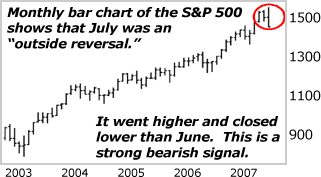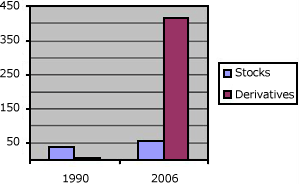Wrestling with the Stock Market Bears
Stock-Markets / US Stock Markets Aug 01, 2007 - 08:33 AM GMTSean Brodrick writes: Is a major bear market creeping up on us? Well, if you were listening to the talking heads on CNBC last week, it sure seemed like it. Sentiment got bearish in a hurry, and good stocks were trampled down with the bad.
Then the bounce on Monday was followed by a red-ink reversal yesterday. The quandary that investors face now is whether this market is:
- A replay of what we saw last May, when things sold off, seemed to recover, then plunged lower or …
- At a true bottom and ready to go higher.
My take: We could see more choppy action in the short term, but some buying opportunities are already out there, and more are soon to come. In fact, I just added some stocks to a few of the portfolios that I run.
More on what I'm buying, and what areas you should look at, in a moment. First …
Why the Bears Say We Will See Another Leg Lower

Tuesday's close was some of the most bearish action we've seen in a long time. It's what technical analysts call a "bearish outside reversal."
In other words, the high was higher than the previous month's high, while the low was lower than the previous month's low.
It's also worth noting that the S&P 500 closed on its low for July.
And keep in mind that the opposite of this pattern, a bullish outside reversal, signaled the start of the big bull run in 2003!
The fundamental reason for Tuesday's decline was the news that yet another mortgage lender — American Home Mortgage Investment — has run into serious trouble. Mike Larson gives you the entire scoop on his blog .
As I've been writing on my own blog recently, the meltdown in the subprime bond market is infecting other areas. Why?
Because as those securities go south, the cost of borrowing rises. This makes it more difficult to do mergers and acquisitions, which depend on cheap debt.
Some bears also argue that a meltdown in U.S. subprime mortgages can send shockwaves around the world since the economy is global now. There have been signs of this happening:
- In Australia, hedge fund Absolute Capital Group suspended withdrawals from two of its funds last week after forecasting losses amid the rout in U.S. subprime mortgages.
- Germany's IKB Deutsche Industriebank confessed to huge losses on U.S. subprime mortgages.
- Another deal — a $10.4-billion loan to finance the takeover of European pharmacy chain Alliance Boots by KKR also got stiffed by the bond market.
The bears will also point out that as market risk rises, big investors tend to lower the proportion of stocks they have in their portfolios and buy bonds.
There are certainly risks out there — big ones. For example, my good friend, world-class currency trader Jack Crooks, has been scaring the stuffing out of me lately by talking about derivatives (a favorite subject of Martin, Mike and Larry, by the way).

Jack recently pointed out:
"Total world stock market capitalization was about $37 trillion in 1990; it grew to about $51.225 trillion in March 2007. According to Morgan Stanley, the total world nominal value of derivatives stood at around $5.7 trillion in 1990; it grew to $415 trillion at the end of 2006.
"It means the dollar value of derivatives is about eight times larger than stocks now, whereas in 1990 stocks were 6.5 times larger than derivatives."
Those are some numbers that will make any investor stop and think about risk!
Hey, the bears may be right … there could be more trouble ahead. But their doom-and-gloom predictions will sure have to hurdle some bullish developments.
Cheaper Stocks, Healthier U.S. Growth And Strong Global Demand for Goods All Point to More Opportunities Ahead
Since 2004, the S&P 500 has seen six corrections of more than 5% (including the latest one). They came in at 8.6% … 8% … 6.4% … 7.6% … 6.6% … and 7.5%. So, investors can be forgiven if they shrug off this latest pullback as just another normal and necessary correction in a bull market.
Plus, thanks to last week's sell-off, the S&P 500 is trading at its best price-to-earnings ratio in more than a decade. And those earnings are getting better — average profit among S&P 500 members is forecast to rise 9% this year and another 11% in 2008, according to a recent Bloomberg survey.
And the bullish case doesn't stop there …
First, according to Credit Suisse, the widening of bond-yield spreads doesn't signal a credit crisis and losses in equities should be short-lived. According to the firm, "Equities are still looking cheap against triple BBB corporate debt, which is the medium of the market."
Second, America's gross domestic product grew at the fastest pace in a year in the most recent quarter — 3.4%. That beat median forecasts of 3.2%. At the same time, the Fed's preferred inflation gauge rose just 1.4%, down from 2.4%. Now, you and I both know the Fed arrives at its inflation numbers by leaving out food and energy costs — which are soaring — but tamer numbers open the chance for a potential rate cut if the Fed thinks the economy needs a boost.
Third, speaking of GDP, the International Monetary Fund raised its forecast for global economic growth to 5.2%, up 0.3% from the forecast it made just three months ago.
Fourth, at the same time, the IMF particularly raised its growth forecasts for China, India and Russia.
That last point is why …
I Continue to Favor Investing In Natural Resource Stocks, Particularly Foreign Ones!
The demand for raw materials from these emerging markets is huge … just HUGE. India has recorded a GDP growth rate of 9.4% during 2006-07. China is growing at a breakneck 11.2%. Russia tags along for the ride at "only" 7% growth.
According to a forecast from Europe's top-ranked natural resources investor, Evy Hambro, — who manages Blackrock's World Mining Fund — Brazil, Russia, India and China will use more aluminum, copper and oil by 2015 than the entire world consumed last year.
Hambro said that, based on current growth projections, those four countries will need 140% of last year's global aluminum demand, 105% of copper output and 121% of all the oil pumped around the world.
Now, I don't know if these supplies even exist! Maybe we'll have to see demand destruction. And how do you get demand destruction in the face of a growing economy? Through higher and higher prices!
In the face of these facts and bullish forecasts, you can see why someone with a long-term, big picture view — me, and hopefully you — should take any stock market meltdown with a grain of salt.
Longer-term, the right natural resources stocks should deliver triple-digit returns because this bull market in commodities has much, much longer to run. And that's why I just told my premium service subscribers to add new positions in precious metals and energy yesterday!
Look, there is nothing wrong with sitting on the sidelines for a bit, just to see if the market has really hit bottom. But when you're ready to put cash to work, take a good look at natural resources stocks. I think there are some great bargains out there right now.
By the way, if you want a diversified approach to investing in the natural resources sector, consider U.S. Global Investors Global Resources Fund (PSPFX) . It targets the whole sector, but moves into whatever areas look hottest. Right now, the fund is focused on energy, and I agree that's a good place to be!
Yours for trading profits,
By Sean Brodrick
This investment news is brought to you by Money and Markets . Money and Markets is a free daily investment newsletter from Martin D. Weiss and Weiss Research analysts offering the latest investing news and financial insights for the stock market, including tips and advice on investing in gold, energy and oil. Dr. Weiss is a leader in the fields of investing, interest rates, financial safety and economic forecasting. To view archives or subscribe, visit http://www.moneyandmarkets.com .
Money and Markets Archive |
© 2005-2022 http://www.MarketOracle.co.uk - The Market Oracle is a FREE Daily Financial Markets Analysis & Forecasting online publication.



